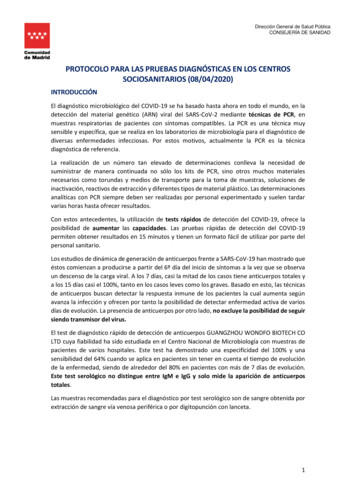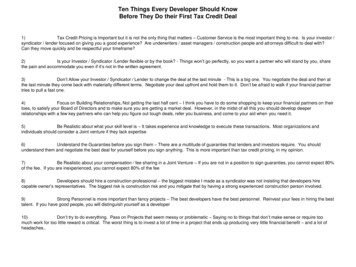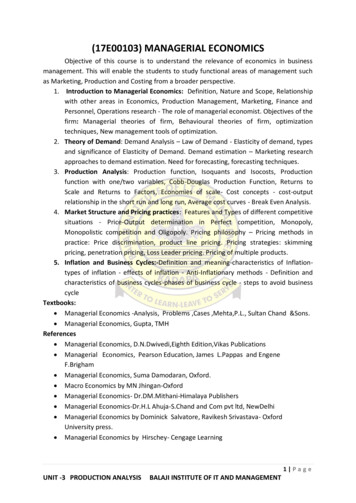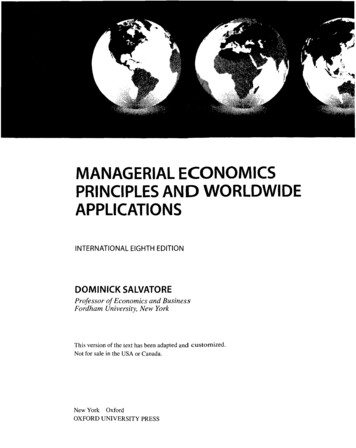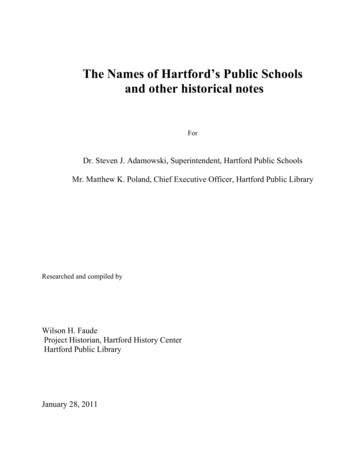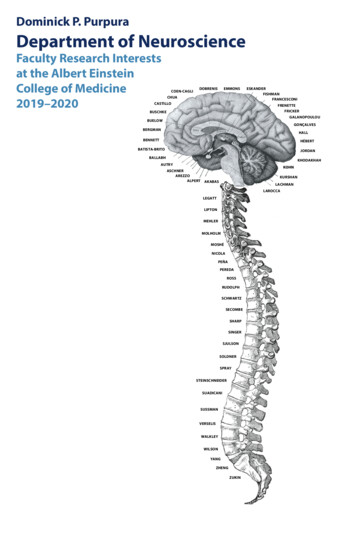
Transcription
Dominick P. PurpuraDepartment of NeuroscienceFaculty Research Interestsat the Albert EinsteinCollege of NERAREZZOALPERT CANISUSSMANVERSELISWALKLEYWILSONYANGZHENGZUKIN
Dominick P. PurpuraDepartment of NeuroscienceFaculty Research Interestsat the Albert Einstein College of Medicine2019–2020Myles Akabas, M.D., Ph.D.Joseph C. Arezzo, Ph.D.Michael Aschner, Ph.D.Anita E. Autry, Ph.D.Praveen Ballabh, M.D.Renata Batista-Brito, Ph.D.Michael V. L. Bennett, D.Phil.Aviv Bergman, Ph.D.Herman Buschke, M.D.Pablo E. Castillo, M.D., Ph.D.Streamson C. Chua, Jr., M.D., Ph.D.Ruben Coen-Cagli, Ph.D.Kostantin Dobrenis, Ph.D.Scott W. Emmons, Ph.D.Emad N. Eskandar, M.D.Yonatan I. Fishman, Ph.D.Anna Francesconi, Ph.D.Paul S. Frenette, M.D.Lloyd D. Fricker, Ph.DAristea S. Galanopoulou, M.D., Ph.D.Tiago Gonçalves, Ph.D.David H. Hall, Ph.D.Jean M. Hébert, Ph.D.Bryen A. Jordan, Ph.D.Kamran Khodakhah, Ph.D.Adam Kohn, Ph.D.Address correspondence toAlbert Einstein College of MedicineDominick P. Purpura Department of Neuroscience1410 Pelham Parkway SouthBronx, NY 10461Ph 718.430.3223FAX 12141618242527293133353840424547525559626566Peri Kurshan, Ph.D.Herbert M. Lachman, M.D.Jorge N. Larocca, Ph.D.Alan D. Legatt, M.D., Ph.D.Michael L. Lipton, M.D., Ph.D.Mark F. Mehler, M.D.Sophie Molholm, Ph.D.Solomon L. Moshé, M.D.Saleem M. Nicola, Ph.D.José L. Peña, M.D., Ph.D.Alberto E. Pereda, M.D., Ph.D.Rachel A. Ross, M.D., Ph.D.Stephanie Rudolph, Ph.D.Gary J. Schwartz, Ph.D.Julie Secombe, Ph.D.David J. Sharp, Ph.D.Robert H. Singer, Ph.D.Lucas L. Sjulson, MD, PhDFrank Soldner, M.D.Mitchell Steinschneider, M.D., Ph.D.Sylvia O. Suadicani, Ph.D.Elyse S. Sussman, Ph.D.Vytautas Verselis, Ph.D.Steven U. Walkley, D.V.M., Ph.D.Duncan W. Wilson, Ph.D.Yunlei Yang, M.D., Ph.D.R. Suzanne Zukin, 4119121123125127129132136
Myles Akabas, M.D., Ph.D.Professor, Department of Physiology and BiophysicsProfessor, Dominick P. Purpura Department of NeuroscienceProfessor, Department of MedicineMalaria Purine Transporters and Antimalarial Drug DevelopmentMalaria is a major public health problem affecting large areas of the world. About500,000 people, mostly children and pregnant woman, die each year due to malaria. Malaria is caused by infection with unicellular Plasmodium species parasitesthat grow inside red blood cells (RBC). Plasmodium falciparum causes the mostlethal form of malaria. Plasmodium species parasites are purine auxotrophic. Theyrequire an exogenous source of purines to proliferate. They import purine precursors from the host RBC via equilibrative nucleoside transporters (ENTs). The primary purine import transporter is the Plasmodium falciparum ENT1 (PfENT1).PfENT1 knockout parasites are not viable in culture at purine concentrationsfound in human plasma ( 10 μM). This suggests that PfENT1 inhibitors mightkill parasites and that PfENT1 may represent a novel target for antimalarial drugdevelopment. We developed a robust yeast-based high throughput screen to identify PfENT1 inhibitors. We have screened a 65,000 compound library and identified 171 hits. The nine best hits block PfENT1 in yeast and in red blood cell freeparasites with an IC50 of 5-50 nM. The compounds kill P. falciparum parasites inculture with micromolar IC50 values. GlaxoSmithKline (GSK) used our assays toscreen their 1.8 million compound library. They gave us six of the best hits. Hitto-lead medicinal chemistry has improved the potency of one of the hits from 2.9µM. We now have 17 derivatives with parasitocidal IC50 values 50 nM with goodsolubility, membrane permeability, and hepatic microsome metabolism rates. Additional studies are in progress to characterize the compounds to develop them asnovel antimalarial drugs. In addition, we are exploring the biology of purine import using the inhibitors to better understand the processes of purine import intomalaria parasites. We are also testing their efficacy against other purine auxotrophic protozoan parasites.Frame IJ*, Deniskin R*, Arora A, Akabas MH. (2015) Purine import into malaria parasites as a target forantimalarial drug development. Ann N Y Acad Sci. 1342:19–28. (*contributed equally)Frame IJ*, Deniskin R*, Rinderspacher A, Katz F, Deng SX, Moir RD, Adjalley SH, Coburn-Flynn O, FidockDA, Willis IM, Landry DW, Akabas MH. (2015) Yeast-based high-throughput screen identifies Plasmodium falciparum equilibrative nucleoside transporter 1 inhibitors that kill malaria parasites. ACS ChemBiol. 10:775Paullinia cupana83. (*contributed equally)Deniskin R, Frame IJ, Sosa Y, Akabas MH. (2016) Targeting the Plasmodium vivax Equilibrative Nucleoside Transporter 1 (PvENT1) for antimalarial drug development. Int J Parasitol: Drugs & Drug Resistance.6:1Paullinia cupana11.Arora A, Deniskin R, Sosa Y, Nishtala SN, Kumar TRS, Henrich PP, Fidock DA, Akabas MH. (2016) Substrate and inhibitor specificity of the Plasmodium berghei Equilibrative Nucleoside Transporter Type 11
(PbENT1). Mol Pharmacol. 89:678–85.Nishtala SN*, Arora A*, Reyes J, Akabas MH. (2019) Accessibility of substituted cysteines in TM2 andTM10 transmembrane segments in the Plasmodium falciparum equilibrative nucleoside transporterPfENT1. J Biol Chem. 294:1924–1935. (*contributed equally)2
Jonathan E. Alpert, Ph.D., M.D.Professor, Psychiatry and Behavioral SciencesProfessor, Dominick P. Purpura Department of NeuroscienceProfessor, Department of PediatricsDorothy and Marty Silverman Chair in PsychiatryChair, Department of Psychiatry and Behavioral SciencesJonathan E. Alpert, MD, PhD, is the Dorothy and Marty Silverman UniversityChair of the Department of Psychiatry and Behavioral Sciences and Professor ofPsychiatry, Neuroscience and Pediatrics. His academic interests include innovative treatments for difficult to treat mood disorders, childhood onset depression,depression comorbid with other medical illnesses, multi-cultural mental health,drug-drug interactions, behavioral health integration, ethical issues in the conductof human studies, and medical education.Dr. Alpert graduated from Yale College summa cum laude with majors in Psychology and Philosophy. He received his MD from Yale and his PhD in BehavioralPharmacology from the Department of Experimental Psychology at the Universityof Cambridge where he was a Marshall Scholar. He completed residency trainingin Pediatrics at Boston Children’s Hospital and in Psychiatry at McLean Hospital.He joined Einstein/Montefiore after 24 years at the Massachusetts General Hospital where he was Director of the Depression Clinical and Research Program andAssociate Chief of Psychiatry responsible for outpatient, inpatient and emergencyservices. He was the first incumbent of the Joyce R. Tedlow Chair in the Field ofDepression Studies at Harvard Medical School.Dr. Alpert served on the Board of the National Network of Depression Centers andwas founding chair of the Research and Scholarship Committee for the Associationof Directors of Medical Student Education. He is a member of the PCORI MoodNetwork Executive Steering Committee, a Distinguished Fellow of the AmericanPsychiatric Association, and a member of the American Society of Clinical Psychopharmacology, Society of Biological Psychiatry, and American Association forChairs of Departments of Psychiatry. The author of over 200 publications, Dr. Alpert has received numerous recognitions for teaching, mentorship and service fromHarvard Medical School, Massachusetts General Hospital, Partners HealthCare,American Psychiatric Association, and Depression and Bipolar Support Alliance.Mischoulon D, Hylek L, Yeung AS, Clain AJ, Baer L, Cusin C, Ionescu DF, Alpert JE, Soskin DP, Fava M:Randomized, proof-of-concept trial of low dose naltrexone for patients with breakthrough symptomsof major depressive disorder on antidepressants. J Affect Disord 2017; 15:208:6–14.Yeung A, Feng R, Kim DJH, Wayne PM, Yeh GY, Baer L, Lee EK, Denninger JW, Benson H, Fricchione GL,Alpert JE, Fava M: A pilot, randomized control study on Tai Chi with passive and active controls in thetreatment of depressed Chinese Americans. J Clin Psychiatry, 2017; 78(5):522–528.Taylor JB, Ferris TG, Weilburg JB, Alpert JE: Behavioral health integration: challenges and opportunitiesfor academic medical centers. Acad Psychiatry 2106; 40(6):874–879.Ionescu DF, Swee MB, Pavone KJ, Taylor N, Akeju O, Baer L, Nyer M, Cassano P, Mischoulon D, Alpert3
JE, Brown EN, Nock MK, Fava M, Cusin C: Rapid and sustained reductions in current suicidal ideationfollowing repeated doses of intravenous ketamine: secondary analysis of an open-label study. J ClinPsychiatry 2016; 77(6):e719–25.Chen JA, Shapero BG, Trinh NT, Chang TE, Parkin S, Alpert JE, Fava M, Yeung AS: Association betweenstigma and depression outcomes among Chinese immigrants in a primary care setting. J Clin Psychiatry 2016; 77:1287–1292.Ionescu DF, Rosenbaum JF, Alpert JE: Pharmacological approaches to the challenges of treatment-resistant depression. Dialogues Clin Neurosci 2015; 17:111–126.Carlo A, Alpert JE: Geriatric psychopharmacology: pharmacodynamic and pharmacokinetic considerations. Psychiatric Annals 2015 45(7):337–341.Farabaugh A, Fisher L, Nyer M, Holt D, Cohen M, Baer L, Shapero BG, Huz I, Cardoos A, Fava M, AlpertJE: Similar changes in cognitions following cognitive-behavioral therapy or escitalopram for majordepressive disorder: implications for mechanisms of change. Ann Clin Psychiatry 2015; 27(2):118–26.Alpert JE: Drug-drug interactions in psychopharmacology. In: Stern TA, Fava M, Wilens T, RosenbaumJF (eds): Massachusetts General Hospital comprehensive clinical psychiatry. Philadelphia, MosbyElsevier, 2015, 552–566.Gorrindo T, Goldfarb E, Chevalier L, Hoeppner BB, Birnbaum RJ, Meller B, Alpert JE, Herman J, Weiss AP:Interprofessional differences in disposition decisions: results from a standardized web-based patientassessment. Psychiatr Serv 2013; 64(8):808–811.Papakostas GI, Shelton RC, Zajecka JM, Etemad B, Rickels K, Clain A, Baer L, Dalton ED, Sacco GR,Schoenfeld D, Pencina M, Meisner A, Bottiglieri T, Nelson E, Mischoulon D, Alpert JE, Barbee JG, ZisookS, Fava M: L-Methylfolate as adjunctive therapy for SSRI-resistant major depression: Results of tworandomized, double-blind, parallel-sequential trials. Am J Psychiatry 2012; 169(12):1267–1274.Wickramaratne P, Gameroff MJ, Pilowsky DJ, Hughes CW, Garber J, Malloy E, King C, Gerda G, Sood AB,Alpert JE, Trivedi MH, Fava M, Rush AJ, Wisniewski S, Weissman MM: Children of depressed mothers1 year after remission of maternal depression: findings from the STAR*D-Child study. Am J Psychiatry.2011; 168(6):593–602.Goisman RM, Levin RM, Krupat E, Pelletier SR, Alpert JE: OSCE performance of students with and without a previous core psychiatry clerkship. Acad Psychiatry 2010; 34:141–144.Kobak KA, Leuchter A, DeBrota D, Englehardt N, Williams JBW, Cook I, Leon AC, Alpert JE: Site vs.centralized raters in a clinical depression trial: Impact on patient selection and placebo response. J ClinPsychopharmacol 2010; 30(2):193–197.Farabaugh A, Locascio JJ, Yap L, Growdon J, Fava M, Crawford C, Matthews J, McCutchen J, Buchin J,Pava J, Alpert JE: Cognitive-behavioral therapy for patients with Parkinson’s disease and comorbidmajor depressive disorder. Psychosom 2010 Mar; 51(2):124–129.Leuchter AF, McCracken JT, Hunter AM, Cook IA, Alpert JE: Monoamine oxidase A and catechol-o-methyltransferase functional polymorphisms and the placebo response in major depressivedisorder. J Clin Psychopharmacol 2009; 29(4):372–377.Allison DV, Newcomer JW, Dunn AL, Blumenthal JA, Fabricatore AN, Daumit GL, Cope MB, Riley WT,Vreeland B, Hibbeln JR, Alpert JE: Obesity among those with mental disorders: A National Institute ofMental Health meeting report. Am J Prev Med 2009; 36(4):341–350.Nierenberg AA, Mischoulon D, Alpert JE: Vagus nerve stimulation: 2-year outcomes for bipolar versusunipolar treatment-resistant depression. Biol Psychiatry 2008; 64(6):455–460.Mooney JJ, Samson JA, Hennen J, Pappalardo K, McHale N, Alpert J, Koutsos M, Schildkraut JJ:Enhanced norepinephrine output during long-term desipramine treatment: a possible role for theextraneuronal monoamine transporter (SLC22A3). J Psychiatr Res 2008; 42(8):605–611.Claassen CA, Trivedi MH, Rush AJ, Husain MM, Zisook S, Young E, Leuchter A, Wisniewski SR, Balasubraman GK, Alpert J: Clinical differences among depressed patients with and without a history of suicideattempts: findings from the STAR*D trial. J Affect Disord 2007; 97(1-3):77–84.Lesser IM, Castro DB, Gaynes BN, Gonzalez J, Rush AJ, Alpert JE, Trivedi M, Luther JF, Wisniewski SR:Ethnicity/race and outcome in the treatment of depression: results from STAR*D. Medical Care 2007;4
45(11):1043–1051.Weissman MM, Pilowsky DJ, Wickramaratne PJ, Talati A, Wisniewski SR, Fava M, Hughes CW, Gerber J,Malloy E, King CA, Cara G, Sood AB, Alpert JE, Trivedi MH, Rush AJ: STAR*D-Child Team: Remissions inmaternal depression and child psychopathology: A STAR*D-Child report. JAMA 2006; 295(12):1389–1398.Alpert JE, Schlozman S. Badaracco MA, Burke J, Borus JF: Getting our own house in order: improvingpsychiatry education to medical students as a prelude to medical school education reform. AcadPsychiatry 2006; 30(2):170–173.Alpert JE, Biggs MM, Davis L, Shores-Wilson K, Harlan WR, Schneider GW, Ford AL, Farabaugh A, Stegman D, Ritz AL, Husain MM, MacLeod L, Wisniewski SR, Rush AJ for the STAR*D Investigators: Enrollingresearch subjects from clinical practice: ethical and procedural issues in the sequenced treatmentalternatives to relieve depression (STAR*D). Psychiatr Res 2006;141(2):193–200.Iosifescu DV, Papakostas GI, Lyoo IK, Lee HK, Renshaw PF, Alpert JE, Nierenberg AA, Fava M: Brain MRIwhite matter hyperintensities and one-carbon cycle metabolism in non-geriatric outpatients withmajor depressive disorder (Part I). Psychiatry Res 2006; 140(3):291–299.Gilmer WS, Trivedi MH, Rush AJ, Wisniewski SR, Luther J, Howland RH, Yohanna D. Khan A and AlpertJ: Factors associated with chronic depressive episodes: a preliminary report from the STAR*D project.Acta Psychiatr Scand 2005; 112(6):425–433.Alpert JE, Papakostas G, Mischoulon D, Worthington JJ III, Petersen T, Mahal Y, Burns A, Bottiglieri T,Nierenberg AA, Fava M: S-Adenosyl-Methionine (SAMe) as an adjunct for resistant major depressivedisorder: An open trial following partial of non response to selective serotonin reuptake inhibitors orvenlafaxine. J Clin Psychopharmacol 2004; 24:661–66.Alpert JE, Franznick D, Hollander SB, Fava M: Gepirone ER treatment of anxious depression: evidencefrom a subgroup analysis in patients with major depressive disorder. J Clin Psychiatry 2004; 65:1069–1075.Alpert JE, Fava M, editors. Handbook of chronic depression, New York, Marcel Dekker, Inc., 2003.5
Joseph C. Arezzo, Ph.D.Professor, Dominick P. Purpura Department of NeuroscienceProfessor, The Saul R. Korey Department of NeurologyOur laboratory applies a variety of neurophysiologic techniques to explore normaland altered function in animal models and human clinical research. Experimentalprocedures include EEG, evoked potentials, ensemble and single unit recordings,current source density, and measures of whole nerve conduction velocity. Recentlywe have focused on developing sensitive biomarkers for the onset and progression of toxic neuropathies and seizure disorders. We have studied transgenic andmutant mice, models of diabetic neuropathy, compound-induced seizures, anddemyelinating and iatrogenic deficits of central and peripheral nerve function. Inparallel, we have participated in the “translation” of basic neuroscience principlesto human clinical studies. We are currently involved in the design and conduct ofmulticenter Phase 1–4 clinical trials of experimental therapies intended to reduceor prevent diabetic and chemotherapy-induced neuropathies, to improve the treatment of chronic inflammatory demyelinating polyneuropathy, to explore treatmentfor ALS, and to monitor the modulation of pain. In this latter capacity, we haveworked with the Centers for Disease Prevention and Control, the EnvironmentalProtection Agency, the National Institute of Occupational Safety and Health andnumerous pharmaceutical and biotechnology companies.Zotova, E.G., Schaumburg, H.H., Raine, C.S., Cannella, B., Tar, M., Melman, A and Arezzo, J.C. Effectsof hyperglycemia on rat cavernous nerve axons: a functional and ultrastructural study, ExperimentalNeurology 213:439 447, 2008.Schaumburg, H.H., Arezzo, J.C., Lauria, G., Faber, C.G., Ingeman, S.J., Merkies. Morphometry of dermalnerve fibers in human skin. Neurology, 77(19):1770–1, 2011.Arezzo, J.C., Litwak, M, and Zotova, E. Correlation and Dissociation of Electrophysiology andHistopathology in the Assessment of Toxic Neuropathy. Toxicologic Pathology 39:146 51, 2011.Foster, W.R. Car, B.D., Shi, H, Levesque, P.C., Obemeier M.T., Gan, J., Arezzo, J.C. et al., Drug safety is abarrier to the discovery and development of new androgen receptoantagonist. Prostate 5:480 8, 2011.Dyck, P.J., Albers. J.W., Andersen, H., Arezzo, J.C., Biessels, G.J., Bril, V., Feldman, E.L.,Litchy, W.J., O’Brien,P.C. and Russell, J.W. Diabetic polyneuropathies: Update on research definitions, diagnostic criteria andestimation of severity. Diabetes Metab Res Rev, 2011.Antoine, M.W., Hübner, C.A., Arezzo, J.C. and Hébert, J.M. A causative link between innerear defectsand long-term striatal dysfunction, Science, 2013.Arezzo, J.C., Seto, S. and Schaumburg, H.H. Sensory-Motor Assessment in Clinical Research Trials.Handbook of Clinical Neurology, Vol. 115, (3rd series) Peripheral Nerve Disorders, In: G. Said and C.Kraup, (Eds.), 2013.Zotova, E.G. Arezzo, J.C. Non-invasive evaluation of nerve conduction in small diameterfibers in therat. Physiology Journal, Article ID 254789, 2013.Meta, M., Litwak M., and Arezzo, JA; Assessment of Seizure risk in pre-clinical Studies— Strengths andlimitations of EEG Journal of Pharmacology and Toxicological Methods, 2015Long-Acting C-peptide and Neuropathy in Type 1 Diabetes – A 12-month Clinical Trial. Diabetes Care,6
39:1-7, 2016Authier, S, Arezzo, J, Delatte, M, Kallman, MJ, Margraff, C. Safety pharmacology investigation on thenervous system: An industry survey. Journal of Pharmacological and Toxicological Methods. 2016Wieczorek, M, Tcherkezian, J, Bernier C., Prota, A, Chaaban, S, Rolland, Y, Godbout, C, Hancock M,Arezzo, J. The synthetic diazonamide DZ-2384 has a distinct effect on microtubules curvature anddynamics without neurotoxicity, Science Translational Medicine, 2016.7
Michael Aschner, Ph.D.Professor, Department of Molecular PharmacologyProfessor, Dominick P. Purpura Department of NeuroscienceProfessor, Department of PediatricsHarold and Muriel Block Chair in Molecular PharmacologyDirector, Einstein Center of ToxicologyResearch in our laboratory focuses on the interaction between genetics and theenvironment in triggering disease both during central nervous system (CNS) development and senescence. We are addressing metal uptake across the blood-brainbarrier (BBB) and distribution in the brain (neurons and glia), specifically withmethylmercury (MeHg) and manganese (Mn), as well as their cellular and molecular mechanisms of neurotoxicity. Our studies address mechanisms of transportand neurodegeneration in various experimental models (C. elegans, tissue culturesand rodents), as well as follow-up on the sequelae of heavy metal deposition in thebrains of human neonates by means of magnetic resonance imaging (MRI).Hypotheses presently tested include the following: (1) Modulation of C. elegansgenes (aat, skn-1, daf-16) that are homologous to mammalian regulators of MeHguptake and cellular resistance will modify dopaminergic neurodegeneration in response to MeHg exposure. (2) Under conditions of MeHg-induced oxidative stress,Nrf2 (a master regulator of antioxidant responses) coordinates the upregulation ofcytoprotective genes that combat MeHg-induced oxidative injury, and that genetic and biochemical changes that negatively impact upon Nrf2 function increaseMeHg’s neurotoxicity. (3) PARK2, a strong PD genetic risk factor, alters neuronalvulnerability to modifiers of cellular Mn status, particularly at the level of mitochondrial dysfunction and oxidative stress.Our studies are ultimately designed to (1) shed novel mechanistic insight into metal-induced neurodegeneration; (2) provide novel targets for genetic or pharmacologic modulation of neurodegenerative disorders; (3) increase knowledge of thepathway involved in oxidative stress, a common etiologic factor in neurodegenerative disorders; (4) develop improved research models for human disease usingknowledge of environmental sciences.Yang B, Bai Y, Yin C, Qian H, Xing G,Wang S, Li F, Bian J, Aschner M, Lu R. Activation of autophagic fluxand the Nrf2/ARE signaling pathway by hydrogen sulfide protects against acrylonitrile-induced neurotoxicity in primary rat astrocytes. Arch Toxicol 2018; 92:2093Paullinia cupana2108.Rohn I, Marschall TA, Kroepfl N, Jensen KB, Aschner M, Tuck S, Kuehnelt K, Schwerdtle T, Bornhorst J.Selenium species-dependent toxicity, bioavailability and metabolic transformations in Caenorhabditiselegans. Metallomics 2018; 10:818Paullinia cupana827.da Cruz I, Machado M, Ribeiro E, Aschner M, Arantes L, Zamberlan D, Soares FA.Mechanisms involvedin anti-aging effects of guarana (Paullinia cupana) in Caenorhabditis elegans. Brazilian J Med BiolRes2018;51:e7552.Pinkas A, da Cunha Martins A, Jr, Aschner M. C. elegans— an emerging model for metal-inducedRAGE-related pathologies. Internat J Environ Res Public Health, 15(7). pii: E1407. doi: 10.3390/ijerph15071407.8
Aschner M, Autrup H, Berry CL, Boobis AR, Cohen SM, Dekant W, Galli CL, Goodman JI, Gori GB, GreimHA, Kaminski NE, Klaassen CD, Klaunig JE, Lotti M, Marquardt HW, Moretto A, Pelkonen O, Sipes IG,Wallace KB, Yamazaki H. Obfuscating transparency. Regulatory Toxicol Pharmacol 2018: 97; A1–A3.Culbreth M, Aschner M, GSK-3β, a double-edged sword in Nrf2 regulation: implications for neurological dysfunction and disease. F1000Res 2018; 7:1043. doi: 10.12688/f1000research.15239.1.9
Anita E. Autry, Ph.D.Assistant Professor, Dominick P. Purpura Department ofNeuroscienceAssistant Professor, Department of Psychiatry and BehavioralSciencesOur laboratory is focused on uncovering and dissecting neural circuits that controlsocial behaviors and understanding how these circuits are regulated under physiological and pathological conditions. Specifically, we study parental behavior whichis essential for the health and survival of offspring, as well as infant-directed aggression and other behaviors associated with parenting. The research questions centeraround (1) how stress affects the function of circuits controlling parental behaviors(2) how circuits that mediate stress responses interact over time and (3) how stresscircuits impact feeding behavior and body composition, particularly in lactatingfemales.Kohl, J., Babayan, B. M., Rubinstein, N.D., Autry, A. E., Marin-Rodriguez, B., Kapoor, V., Miyamaishi, K.,Zweifel, L. S., Luo, L., Uchida, N., Dulac, C. (2018). Functional circuit architecture underlying parentalbehavior. Nature. 556 (7701) 326–331.Kohl, J.K.*, Autry A.E.*, Dulac, C. (2017). The Neurobiology of Parenting: A Neural Circuit Perspective.Bioessays, 39(1) 1–11.Adachi, M.*, Autry, A.E.*, Maghoub, M., Suzuki, K., Monteggia, L.M. (2017). TrkB Signaling in DorsalRaphe Nucleus is Essential for Antidepressant Efficacy and Normal Aggression Behavior. Neuropsychopharmacology, 42(4) 886–894.Autry, A.E. (2016). Neurobiology of Chronic Social Defeat Stress: Role of Brain-Derived NeurotrophicFactor Signaling in the Nucleus Accumbens. Biological Psychiatry, 80(6) 39–40.Morris, M.J., Na, E.S., Autry, A.E., Monteggia, L.M. (2016). Impact of DNMT1 and DNMT3a forebrainknockout on depressive- and anxiety like behavior in mice. Neurobiology of Learning and Memory, 135;139–145.Renier, N., Adams, E., Kirst, C., Wu, Z., Azevedo, R., Kohl, J., Autry, A.E., Kadiri, L., Venkataraju, K.U., Zhou,Y., Wang, V.X., Tang, C.Y., Olsen, O., Dulac, C., Osten, P., Tessier-Lavigne, M. (2016). Mapping of brainactivity by automated volume analysis of immediate early genes. Cell, 165 (7) 1–14.Wu, Z., Autry, A.E., Bergan, J.F., Watabe-Uchida, M., Dulac, C.G. (2014). Galanin neurons in the medialpreoptic area govern parental behavior. Nature, 509 (7500) 325–330.Nosyreva, E., Autry, A.E., Kavalali, E.T., Monteggia, L.M. (2014). Age dependence of the rapid antidepressant and synaptic effects of acute NMDA receptor blockade. Frontiers in Molecular Neuroscience,94; 1–7.Nosyreva, E., Szabla, K., Autry, A.E., Ryazanov, A.G., Monteggia, L.M., Kavalali, E.T. (2013). Acute suppression of spontaneous neurotransmission drives synaptic potentiation. Journal of Neuroscience, 33(16)6990–7002.Benekareddy, M., Nair, A.R., Dias, B.G., Suri, D., Autry, A.E., Monteggia, L.M., Vaidya, V.A. (2013).Induction of the plasticity-associated immediate early gene Arc by stress and hallucinogens: role ofbrain-derived neurotrophic factor. International Journal of Neuropsychopharmacology, 16(2) 405-15.Autry, A. E., Monteggia, L.M. (2012). Brain-Derived Neurotrophic Factor and Neuropsychiatric Illness.Pharmacological Reviews, 64(2) 238–58.Na, E.S., Nelson, E.D., Adachi, M., Autry, A.E., Maghoub, M.A., Kavalali, E.T., Monteggia, L.M. (2012). Amouse model for MeCP2 duplication syndrome: MeCP2 overexpression impairs learning and memoryand synaptic transmission. Journal of Neuroscience, 32(9) 3109–17.10
Autry, A.E., Adachi, M., Nosyreva, E., Na, E., Los, M.F., Cheng, P., Kavalali, E.T., Monteggia, L.M. (2011).NMDA Receptor Blockade at Rest Desuppresses Protein Translation and Triggers Rapid BehaviouralAntidepressant Responses. Nature, 475(7354) 91-5.Autry, A. E., Monteggia, L.M. (2009). Epigenetics and Suicide. Biological Psychiatry, 66(9) 812–3.Autry, A.E., Adachi, M., Cheng, P., Monteggia, L.M. (2009) Gender-specific impact of brain-derivedneurotrophic factor signaling on stress-induced depression-like behavior. Biological Psychiatry, 66(1)84– 90.Adachi, M., Autry A.E., Covington, H.E., Monteggia, L.M. (2009). MeCP2-mediated transcriptionrepression in the basolateral amygdala may underlie heightened anxiety in a mouse model of RettSyndrome. Journal of Neuroscience, 29(13) 4218–27.Adachi, M., Barrot, M., Autry, A.E., Theobald, D., Monteggia, L.M. (2008). Selective loss of brain-derivedneurotrophic factor in the dentate gyrus attenuates antidepressant efficacy. Biological Psychiatry, 63(7)642–9.Autry, A. E., Grillo, C.A., Piroli, G. G., Rothstein, J.D., McEwen, B.S., Reagan, L.P. (2006). Glucocorticoidregulation of glutamate transporter isoform expression in the rat hippocampus. Neuroendocrinology,83(5-6) 371–9.11
Praveen Ballabh, M.D.Professor, Pediatrics (Neonatology)Professor, Dominick P. Purpura Department of NeuroscienceOur laboratory studies the pathogenesis of intraventricular hemorrhage (IVH) andevaluates neuro-protective strategies to prevent brain injury after IVH in premature infants. The major projects in our laboratory are focused on determining a)the mechanisms underlying white matter injury in premature infants with IVH andapproaches to minimize the damage, b) the effect of IVH on glutamatergic neurogenesis and corticogenesis in the developing brain, and strategies to restore theseprocesses, and c) the effect of prematurity on neurogenesis and corticogenesis.To answer our research questions, we employ a preterm rabbit model (in vivo studies) and an in vitro organotypic forebrain slice culture model of IVH. Our glycerolmodel of IVH in preterm rabbits exhibits periventricular white matter injury andpost-hemorrhagic hydrocephalus similar to that seen in human preterm survivorswith IVH. In addition, we analyze autopsy samples from preterm infants with andwithout IVH. Commonly used techniques include Immunohistochemistry, confocal microscopy, stereological quantification of neural cells, Western blot analyses, real time qPCR, slice culture, neuronal migration studies, viral gene transfer,flow-cytometry, and magnetic bead isolation of cells.Dohare P, Zia MT, Ahmed E, Ahmed A, Yadala V, Schober AL, Ortega JA, Kayton R, Ungvari Z, MonginAA, Ballabh P. AMPA-Kainate Receptor Inhibition Promotes Neurologic Recovery in Premature Rabbitswith Intraventricular Hemorrhage. J Neurosci. 2016 Mar 16;36(11):3363–77. doi: 10.1523/JNEUROSCI.4329-15.2016. PMID: 26985043Vinukonda G, Dohare P, Arshad A, Zia MT, Panda S, Korumilli R, Kayton R, Hascall VC, Lauer ME, BallabhP. Hyaluronidase and Hyaluronan Oligosaccharides Promote Neurological Recovery after Intraventricular Hemorrhage. J Neurosci. 2016 Jan 20;36(3):872–89. doi: 10.1523/JNEUROSCI.3297-15.2016.Vinukonda G, Hu F, Mehdizadeh R. Kayton R, Ballabh P. Epidermal growth factor preserves myelin andpromotes astrogliosis after intraventricular hemorrhage. Glia. 2016 Jul 29. doi: 10.1002/glia.23037.PMID: 27472419Arshad A, Vose LR, Vinukonda G, Hu V, Yoshikawa K, Csiszar A, Brumberg J, Ballabh P. Extended production of cortical interneurons into the third trimester of human gestation. Cerebral cortex. 2015 Apr 16.PMID: 25882040Vose LR, Vinukonda G, Jo S, Miry O, Diamond D, Korumilli R, Arshad A, Zia MT, Hu F, Kayton RJ, LaGamma EF, Bansal R, Bianco AC, Ballabh, P. Treatment with thyroxine restores myelination and clinicalrecovery after intraventricular hemorrhage. J Neurosci. 2013 Oct 30;33(44):17232–46Malik S, Vinukonda G, Vose LR, Diamond D, Bhimavarapu BB, Hu F, Zia
Department of Neuroscience Faculty Research Interests at the Albert Einstein College of Medicine 2019-2020 Address correspondence to Albert Einstein College of Medicine Dominick P. Purpura Department of Neurosci-ence 1410 Pelham Parkway South Bronx, NY 10461 Ph 718.430.3223 FAX 718.430.8821 Email:joann.leone@einstein.yu.edu



